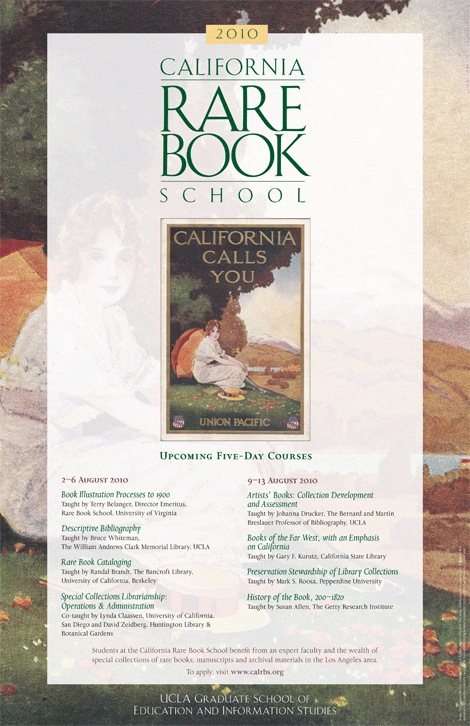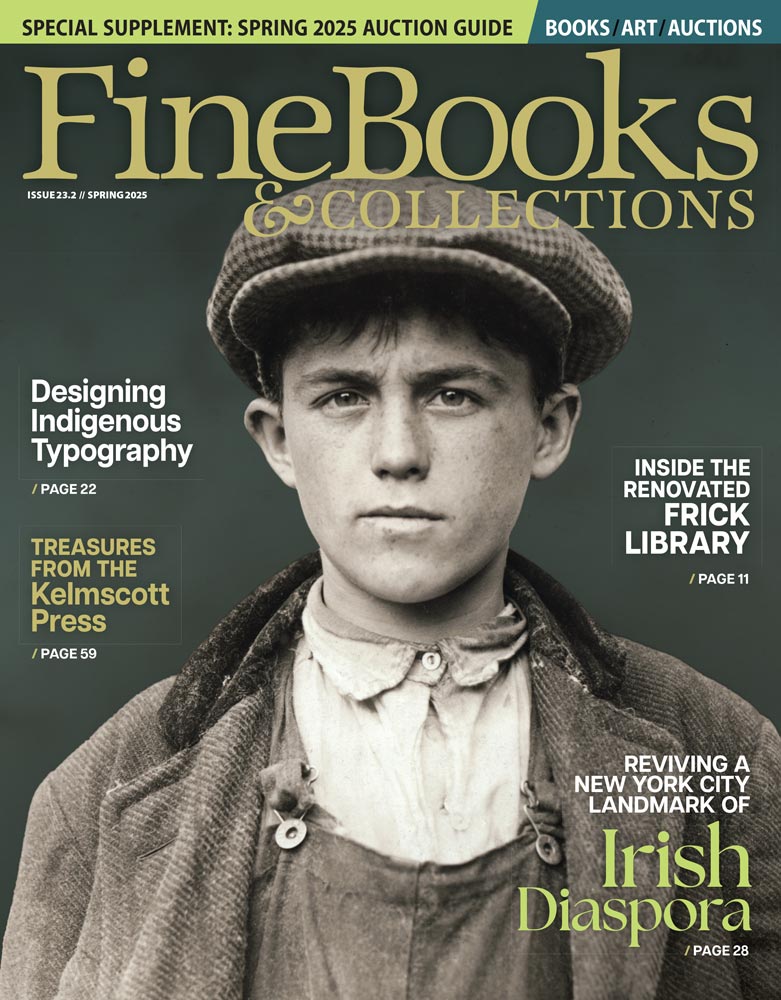Sweet Briar College in Virginia announced the winners of its Nicole Basbanes Student Book Collecting Contest (Sweet Briar alumna Nicole is the daughter of author and FB&C columnist Nick Basbanes, as well as a special collections librarian.) Courtney Cunningham, a classics major, won $300 for her collection of approximately 40 Alexander the Great books. As the first-place winner, she will proceed to the National Collegiate Book Collecting Contest. Congratulations!
Sweet Briar College in Virginia announced the winners of its Nicole Basbanes Student Book Collecting Contest (Sweet Briar alumna Nicole is the daughter of author and FB&C columnist Nick Basbanes, as well as a special collections librarian.) Courtney Cunningham, a classics major, won $300 for her collection of approximately 40 Alexander the Great books. As the first-place winner, she will proceed to the National Collegiate Book Collecting Contest. Congratulations!
The book was printed in a letterpress edition of 140 copies on Arches mouldmade paper and quarter-bound in African goat skin by Bird & Bull Press. Books can be purchased for $425 by contacting birdandbull@yahoo.com.
Jonathan Shipley
Jonathan Shipley is a freelance writer living in Seattle. He’s written for the Los Angeles Times, Gather Journal, Uppercase, and many other publications.
Print your own. Time Magazine highlights London's Newspaper Club.
How does it work? From the piece...
In an era when traditional newspapers are hemorrhaging readers and staff as their revenues head south, the year-old Newspaper Club is proving there's still untapped demand for the medium -- just not in the traditional sense. The kinds of papers Newspaper Club's clientele tend to print include bloggers' fanzines, literary works, school journalism projects and wedding-day keepsakes. The company also has a growing list of corporate clients, including the BBC, Wired's U.K. edition and smoothie-maker Innocent Drinks. Newspaper Club isn't about the news or the content, explains co-founder Russell Davis, "it's about ink on paper."
Here's how it works: Gather the words, pictures and graphics you want to see in print. Then design your 12-page (minimum) tabloid-size paper -- either by using Newspaper Club's on-site layout tool and your own software and sending the result to the site as a PDF, or by letting the site's in-house designers do the job for you. Newspaper Club then arranges for a printer to handle your press run and ships the finished work to your door. "It's like hitting the print button [on a computer] in bulk," says Ben Hammersley, editor at large for Wired's U.K. edition, which used Newspaper Club to print 500 copies of a compendium of highlights from several issues of the magazine and then gave them away at two events it sponsored.
The Newspaper Club's formula is based on a dirty little secret in the newspaper business: the giant presses that pump out daily papers by the millions every morning or afternoon sit idle for most of the rest of the day. To fill their downtime, printing plants do small press runs at surprisingly affordable prices.
- The expected top seller did end up on top of the heap: a 12-volume mixed-edition set of Blaeu's Atlas Major (1662-1681), housed in a special cabinet constructed by Milan's Colombo Mobili, was expected to make £180,000-200,000; it sold for £289,250.
- A copy of Coronelli's Navi o vascelli, galee, galeazze, galeoni (1697), a very rare collection of ship portraits, sold for £75,650.
There are so many times I wished I had a bricks and mortar bookshop -- to interact with customers every day, to be able to play with displays of books, and to have the sense that I am, indeed, a real bookseller.
There are numerous reasons why that's not a practical thought at this stage in my life -- one of which is the fact that I want to be home after school and on weekends, when my kids are home, and not at a shop across town. Still, if I had a brick and mortar shop, I could also hang up beautiful posters about books, like this one, in the window:
Then I realize that my website
and this blog are a sort of virtual store. Pretend that you're walking
down the street (to your favorite bookseller, natch) and you see the
above poster in the window of her shop. ![]()
I attended the California Rare Book School, held at UCLA each summer, two summers ago, taking the Books in the Far West course taught by Gary Kurutz of the California State Library (and, not coincidentally, author of the book California Calls You among others). I had a wonderful time and highly recommend it to collectors, booksellers, and librarians. I am already plotting how I can fit in another week away so I can return to Cal RBS. And, yes, some scholarships are available. Go for it!
See you in the stacks!
"The Grand Opening was a magnificent success and got the new shop off to a great start! I don't know if Bob Fleck's staff kept count, but at least a hundred librarians, collectors and booksellers, as well as local and state politicians, were on hand to watch the four partners take a giant pair of scissors to cut the ceremonial ribbon ... The shop has a website and all four dealers are no strangers to selling on the Internet, but I think it was a success because people who love books know there is no substitute for seeing them in person, and holding them in your hands. The digital age is wonderful, but for bibliophiles it only reinforces the irreplaceable appreciation for the book as physical objects. Similarly, browsing in a bricks and mortar book store is a unique experience, full of serendipity and surprise, and one we're happy to provide."
The Bookshop is located in New Castle, Delaware, just minutes from I-95 and the Delaware Memorial Bridge. It will be open for browsers and buyers Monday through Saturday, from 9 a.m. to 5 p.m.
Images courtesy of Between the Covers Rare Books. You can see more on their Facebook page.
Staley was appointed in 1988 at a time when the HRC was at a crossroads, having been vaulted into the top tier of institutional collections by the late provost Harry Huntt Ransom, who had declared in 1957 his intention to create what he called a "Biliotheque Nationale" in the "only state that started out as an independent nation." The decidedly unconventional approach Ransom pursued to achieve this goal became the stuff of legend--it was what I came to describe as a form of institutional bibliomania that transformed what was then a very good library into a great one--and was at the core of a chapter I wrote for A Gentle Madness that I called "Instant Ivy."
When Staley came to Austin, the massive repository was already filled to bursting with millions of pages of documents, the pace of acquisition so frenetic that many thousands of them were not even catalogued yet. One person familiar with the meteoric growth, the English bookseller Colin Franklin, told me at the time that what the HRC needed to get itself on a steady course "and settle down a bit" was a person like Staley, who, as it turns out, did measurably more than act as caretaker. What he did in essence was to build on greatness and create his own distinctive identity, in much the same way that Mickey Mantle followed Joe Dimaggio into center field for the New York Yankees (or, for Red Sox fans, having Yaz take over left field in Fenway Park for Ted Williams.)
As an administrator, Staley raised $100 million for the center's programs; in collection development, he added a succession of remarkable literary archives, Norman Mailer, Don DeLillo, Isaac Bashevis Singer, Doris Lessing, Julian Barnes, Elizabeth Hardwick, Penelope Fitzgerald, Stella Adler, and Bernard Malamud among them, and he made headlines around the world when he acquired the Watergate files of Washington Post investigative reporters Bob Woodward and Carl Bernstein. Just as significant, in my view, was a new policy of openness and accessibility that Staley introduced at the HRC, making materials much easier for scholars to use. William Powers, president of the university, summed up his contributions with these words: "We owe a great debt of gratitude and deepest appreciation to Tom Staley."
A search will be conducted to name his replacement.



